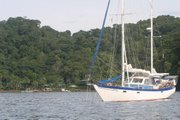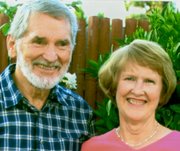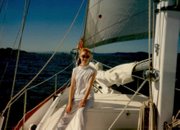On this our last leg of the passage to the City, we have another story to tell. Though the southwest winds were light, as was the rain, the swells were quite large, in the 6-foot range. Alphy had begun to work again the last couple of days, so we set the course and let him steer.
About 20 miles into the 40-mile passage, Carricklee headed widely off to starboard, then back to port, and kept going to port, making a full circle. When we turned off the autopilot to steer manually, we had no steerage. Thinking the autopilot hadn’t disengaged, we shut off the power to it on the electrical panel. Nothing changed. Fortunately, we had no traffic to watch out for as we bobbed around in the swells.
Bob went below to check the hydraulic steering system in the bilge and found red hydraulic oil floating on top of the bilge water. All the oil had drained out of the system, leaving us without steering from either the autopilot or the helm.
When he gave me this report, my heart sank. This was a scene straight out of a recurring nightmare that I have less frequently nowadays, but still occasionally after these almost 20 years of sailing. In this nightmare I’m at the helm and run Carricklee up on shore. The boat miraculously continues to move inland. Then I realize boats need water for locomotion. I must get Carricklee back to the ocean. But I discover to my dismay I have no steering. I’m helpless. Then I wake up.
The always calm—well, almost always—Captain Bob assured me we weren’t wholly without steerage. Though we didn’t have sufficient wind for the wind vane to work and the little auxiliary auto helm is too erratic and difficult to use to take through the busy harbor we were approaching, Bob could stand back on the transom, with the wind vane shaft in his hand, and control the rudder. I would control the throttle. This scenario reminded me of a family story. Two grandchildren of my brother Mylon were driving a golf cart in this manner, one at the wheel and the other on the pedals and ran into another grandchild, breaking her leg. As bad as that was, I thought the potential for disaster here was even worse.
Our choices, however, were decidedly limited. The boat also has, as do all boats, an emergency tiller built in, but ours is below decks, under our bunk, and requires a lengthy set-up. And I’d still be in control of the throttle above deck, calling down steering directions. Worse and worse.
By this time we were within 2-3 miles of the anchorage area for ships waiting to transit the Canal. Few of them were on the move, so that was good. Once in the middle of them, however, one approaching from the west came up on our stern, obviously traveling much faster than could we. We hailed the ship, now close enough to easily read its name without binoculars, on VHF 16, and asked what the captain’s intentions were. The response in heavily accented English was that the captain planned to anchor about where we were. Bob explained our reduced speed, necessitated by the sluggishness of the hand-control of the rudder, and the captain agreed to slow down and not run us over.
After that, we called the Balboa Yacht Club, a panga met us as we approached the mooring area, and Bob followed his lead to a mooring. Then Bob abandoned his post at the rudder and went forward to take the line from the panga driver while I reversed as needed. Safely in port!
Thursday, November 30, 2006
Subscribe to:
Post Comments (Atom)






No comments:
Post a Comment